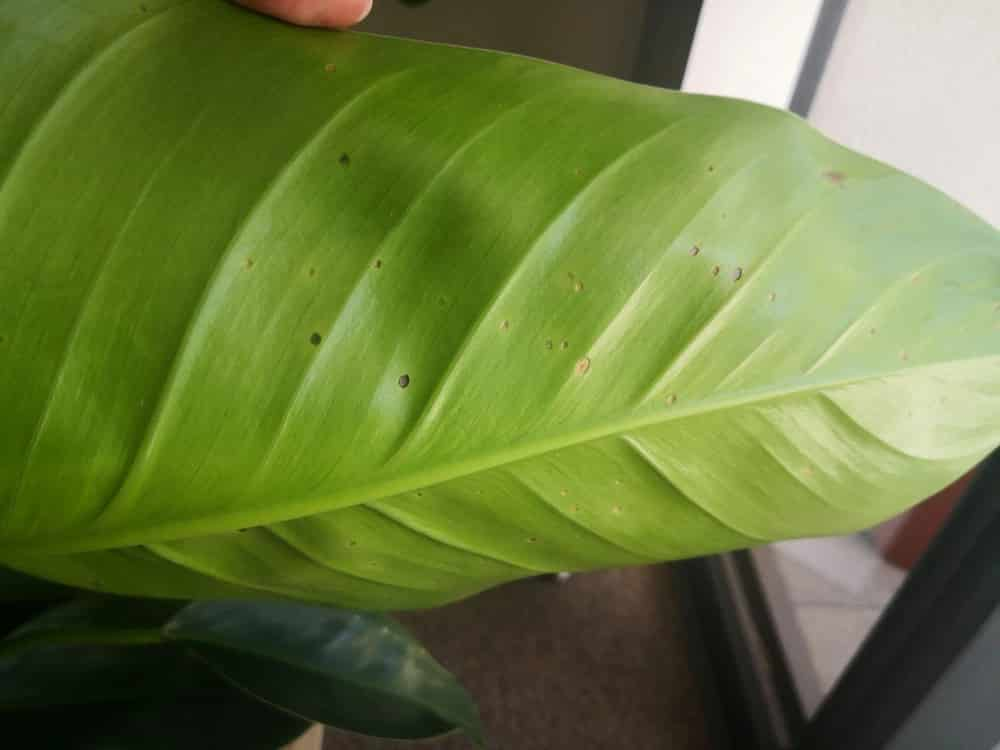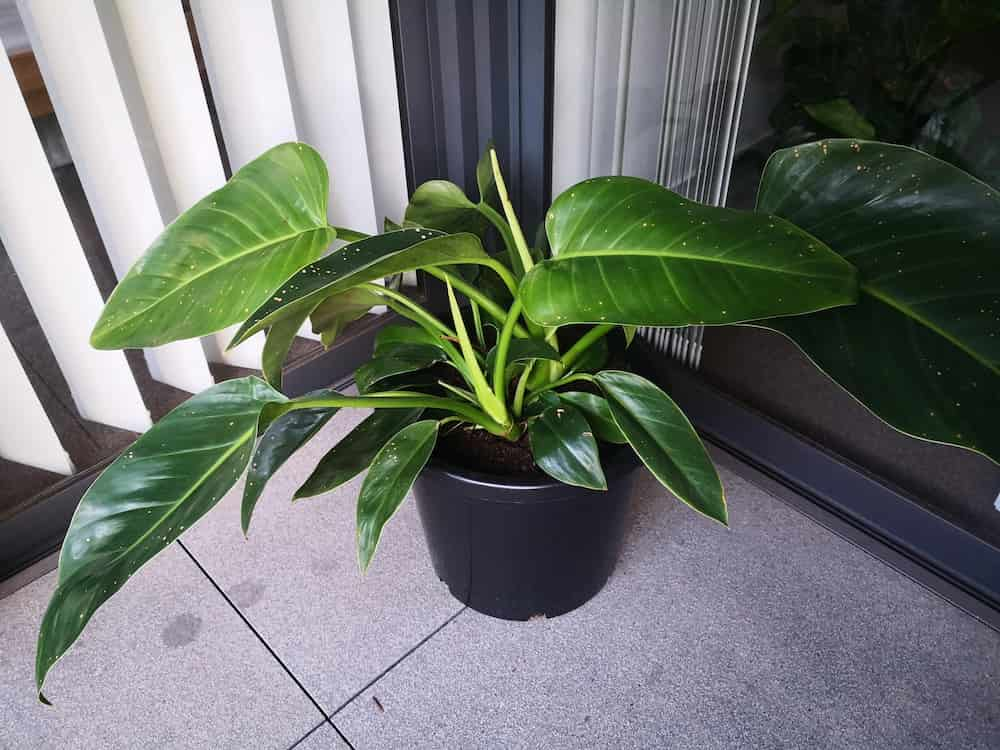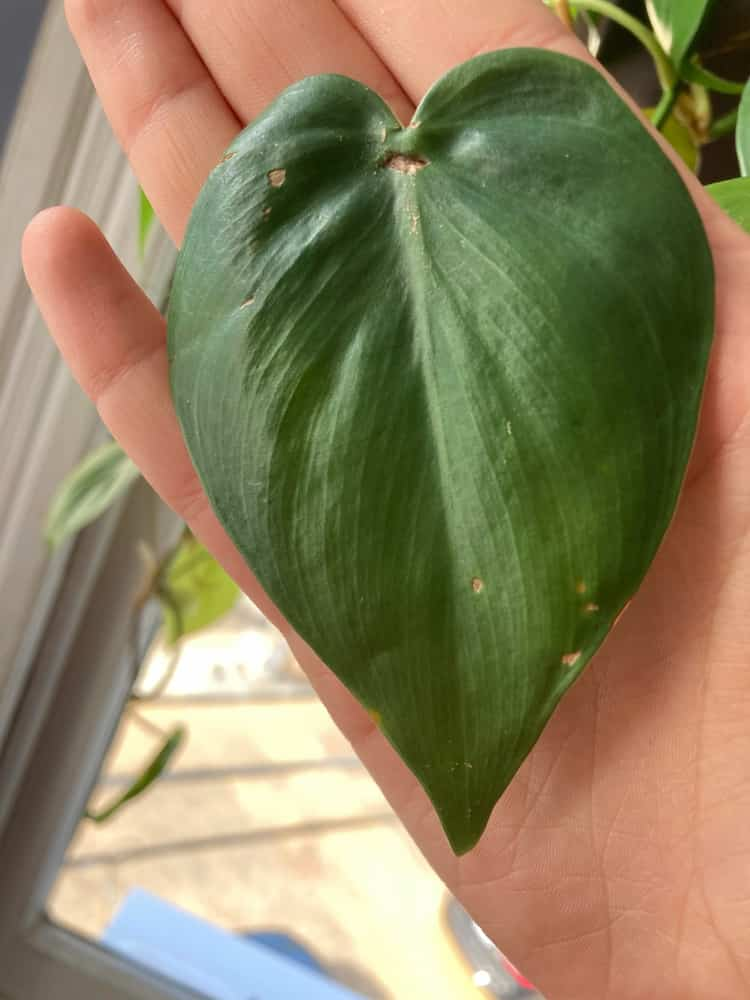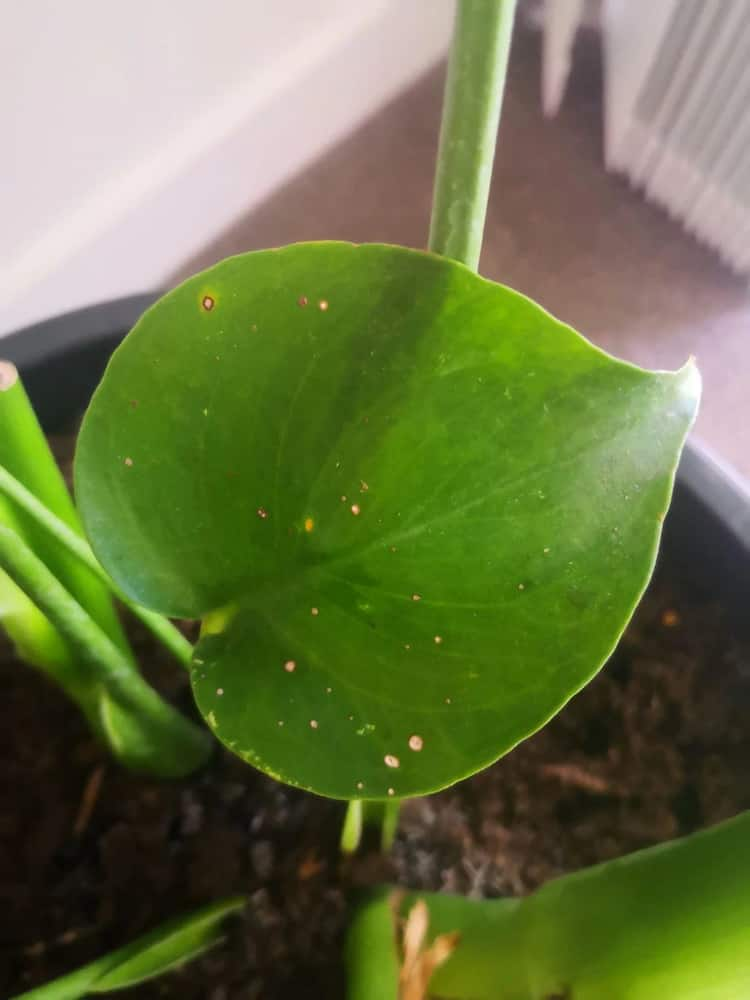Philodendrons are popular houseplants that add interest, texture, and a tropical feel to any room. They are easy to care for, making them a wonderful option for newbies. That doesn’t mean, however, that they are immune to any problems.
One issue to keep a look out for is when your philodendron has brown spots. Brown spots on philodendrons can be caused by a number of things, including improper care, diseases, and pests.
Keep reading to learn why your philodendron leaves have brown spots.

Table of Contents
Why does my philodendron have brown spots?
Overwatering, diseases, excessive sunlight, and pest infestations are just some of the reasons why philodendron leaves have brown spots. The spots could also be a natural part of the philodendron and nothing to be worried about. Knowing what is causing the spots can help you better handle any potential problem.
This often comes down to a process of elimination, so checking each of the causes and considering if they could apply to your plant is usually the best strategy here.
1. Some brown spots are naturally occurring
There are some philodendron species, such as Philodendron pastazanum, that have brown spots. These spots are called nectaries and they are naturally occurring, typically appearing on the leaf stems but can occur on the leaves as well.
Nectaries play an important part in healthy philodendrons. When the plant is growing healthy and strong, it will secrete the sweet nectar, also known as sap, from these spots. This substance attracts insects to help pollinate the plants.
If the philodendron’s brown spots are actually nectaries, then there is nothing you need to do. These are naturally occurring and simply a sign that everything is right with the plant.

2. The philodendron has soggy roots
Keeping the philodendron’s roots soggy is one of the quickest ways to make a healthy philodendron unhealthy. Not only does it cause brown spots on the leaves of the plant, but it can also result in root rot in your philodendron, which will kill the plant.
FYI: Soggy roots are caused by either overwatering or compact soil, or a combination of both. One of the first symptoms of soggy roots are yellowing leaves on your philodendron, along with stunted growth, and brown spots.
3. Too much sunlight
Another potential cause of your philodendron leaves having brown spots is too much sunlight. Philodendrons are native to a tropical environment where they are protected by the trees’ canopy. This means they are out of direct sunlight.
So, when they are put in direct light, they can start showing symptoms of damage, such as brown spots. Additionally, too much sunlight can also cause a slew of other problems for the plant, including stunting your philodendron’s growth rate.
Find out more: Philodendron Light Needs: The Ultimate Guide
4. The philodendron isn’t getting enough humidity
Philodendrons prefer a higher humidity, and not providing them with the amount of humidity can cause brown spots to appear on the philodendron’s leaves. In fact, these plants thrive at humidity levels of 70 to 90 percent.
When the humidity isn’t high enough, the philodendron can also dry out much quicker than if it was given the proper amount of humidity. It also may not grow as well as a philodendron that did receive the right humidity.

5. Incorrect fertilization can cause brown spots
When your philodendron has brown spots, it could be caused by applying the wrong amount of fertilizer. Additionally, too much fertilizer can damage the plant’s roots and cause the plant’s overall health to suffer.
Along with brown spots, excess fertilizer can cause a whitish residue to form on the top of the plant’s soil.
Along with the incorrect amount of fertilizer being applied, adding a low quality feed can also cause the philodendron to develop brown spots on its leaves. That is why it is important to use a trusted brand of fertilizer.
Best fertilizer for Philodendrons
Jack’s Classic 20-20-20 All Purpose Fertilizer
A great fertilizer with the perfect balance for your philodendron. Simply dissolve in water and feed your plant to watch it thrive.
6. Poor air circulation can damage the philodendron
Plants need air circulation to help dry any surface moisture that may collect on the plant’s leaves. When there isn’t adequate circulation, the moisture sits on the leaves, causing brown spots and other damage to the philodendron’s foliage.
Air circulation is extremely important if you mist your philodendron. Without air circulation, the water would simply sit on the leaves and increase the chance of problems.

7. Fungal leaf spot is a disease that can cause brown spots on leaves and stems
When your philodendron leaves have brown spots, it could be that the plant is infected with philodendron leaf spot disease. This is caused by a fungal pathogen known as Dactylaria humicola. It is most commonly seen in hot and wet conditions, and usually presents itself on the younger leaves first.
There are also some bacterial pathogens that can also cause brown spots to appear on the philodendron’s leaves. However, these are not as common as fungal leaf spots.
8. Philodendrons will develop brown spots when there is a pest infestation
It is not uncommon for houseplants, such as philodendrons, to experience the occasional pest infestation. Spider Mites, mealybugs, and scales are just a few of the pests that can attack the philodendron.
These pests use their sharp mouthparts to pierce the philodendron’s foliage and suck out their juices. This will cause brown spots to appear on the leaves and stems of the infested plant.

9. The temperature is too cold for the philodendron
Philodendrons grow the best when they are at temperatures between 65 and 85 degrees Fahrenheit. If the temps are too low, the philodendron can develop brown spots on the leaves and wilted stems, as well as your philodendron not growing much, if at all.
Additionally, when a philodendron has brown spots, it could be the result of placing the plant in an area where the temperatures fluctuate drastically. This can cause stress and damage to the plant.
10. Poor water quality can cause leaf discoloration
Like too much fertilizer, tap water can cause a build up of salt to accumulate in the soil, which then causes the philodendron to develop brown spots on its leaves.
This is because most tap water contains a large amount of chlorine and sodium, both of which are not good for philodendrons and can act in a manner similar to over-feeding the plant.

11. Brown spots can appear if the growing medium isn’t suitable for philodendrons
Philodendrons do like moist soil, but too much moisture can lead to soggy roots, which can then cause root rot. Once root rot has taken hold of the plant, the overall health of the philodendron will quickly decline. In most cases, root rot will kill the plant.
To make matters even worse, trying to get rid of root rot is extremely difficult and there is no cure for this fungal disease. Gardeners typically have to cut their losses when their plant develops root rot and discard the infected plant.
12. Low light can cause brown spots on philodendrons
While not as common as some of the other causes of brown spots, leaving your philodendron in an area with low levels of light can sometimes cause brown spots to appear on the plant’s foliage.
You may also notice that your philodendron’s growth rate has slowed, yellowing leaves, and just an overall wilted and limp appearance.
13. Brown spots on leaves can appear when the philodendron is underwatered
Underwatering a philodendron isn’t nearly as damaging as overwatering, but that doesn’t mean it won’t cause problems for the plant. Not giving the philodendron enough water can cause brown, dry spots to form on its leaves.
The good news is that this problem can easily be corrected by simply watering the plant. With that said, however, the brown, dry spots won’t go away even after the problem is corrected, but new leaves won’t have the same problem.

Why does my philodendron have brown spots on its stems?
When your philodendron stems have brown spots, it could actually be a sign that your plant is healthy and growing well. Some philodendron species produce brown spots on their stems that secrete sweet sap. These spots are called nectaries, and their whole purpose is to try to attract pollinators to the plant.
Nectaries are not something to be concerned about. Unfortunately, they are not the only cause of brown spots on philodendron stems. Other potential causes are stem rot, pest infestation, and poor care.
Knowing whether the brown spots are a cause for concern is an important part of gardening. If there are other symptoms that appear along with the brown spots, such as poor growth, mold or mildew, wilting, and leaf drop, then the spots are probably not nectaries and should be addressed as soon as possible.
How do you treat brown spots on philodendron leaves?
When a philodendron has brown spots, the best treatment is to always provide the plant with proper care. This will also go a long way to keeping future problems at bay. Additionally, a healthy philodendron is much more likely to withstand pests and disease issues better than one that isn’t healthy.
That said, identifying the specific reason why your philodendron has brown spots can, in turn, help you address the root cause, helping you to ensure it doesn’t happen again.
1. Avoid overwatering the philodendron
Overwatering is one of the most common causes if your philodendron has brown spots. When you give the plant too much water, its roots stay soggy, which means it cannot properly absorb the nutrients in the soil.
You can help stop overwatering from occurring by simply checking the soil moisture before watering the philodendron. Insert your finger about 2 inches into the plant’s soil, and only water when it starts to feel dry.

2. Grow the plant in the right soil
Another cause of soggy roots is growing the philodendron in compact soil. The best soil for philodendrons is a loose, airy mix that not only retains the right amount of moisture, but also allows for the excess water to drain out properly.
Best soil for Philodendrons
Miracle-Gro Tropical Potting Mix
Light and well-draining (perfect for avoiding root rot) while being packed with just the right nutrients – that will feed your plant for up to six months. The best soil for keeping your philodendron healthy and strong.
3. Move the plant out of direct sunlight
Direct sunlight will quickly cause the philodendron leaves to have brown spots, while also stunting the plant’s growth.
Keeping your plants out of direct sunlight will keep these unsightly discolorations at bay. Aim for a location that receives bright but indirect light.
Near a sunny window that has a sheer curtain or blind will typically provide the philodendron with the right light. This filtered light isn’t too harsh for the plant but will still provide it with the bright light it needs. Alternatively, you can use artificial lighting as well.
4. Avoid over fertilizing the philodendron
Feeding your philodendron with a balanced, liquid fertilizer, such as 20-20-20, will help promote healthy growth.
This fertilizer should only be applied at 1/2 strength once a month during the spring and summer. Cut back the feeding to once every 8 weeks in the fall and winter.
Fertilizing your philodendron with commercially available products isn’t the only option for feeding philodendrons. You can also use compost, fish emulsions, and worm castings instead.
These are more natural options for feeding the plant, and some people prefer to use an organic fertilizer option instead of ones filled with chemicals.

5. Increase the humidity level around the plant
One of the easiest ways to increase the humidity level around the philodendron is to use a drip tray. Drip trays are shallow trays that you fill with small pebbles, and the philodendron will sit on top of the tray.
The excess water that drains out of the philodendron’s pot will collect in the drip tray and then naturally evaporate into the air around the plant. This will cause the humidity level to increase in that area, and help to prevent damage caused by low humidity.
6. Protect the philodendron from fungal and bacterial diseases
Once your plant has philodendron leaf spot disease, trying to get rid of it can be difficult. Because of this, it is always best to try to prevent the issue from occurring in the first place. This can be done by watering the philodendron at its base and not from above.
That doesn’t mean, however, that there isn’t a treatment for these diseases. Liquid copper is a philodendron bacterial leaf spot treatment that can successfully get rid of this disease if applied properly. You will need to remove the leaves that are infected and then treat new leaves with the liquid once every 10 to 14 days.
7. Regularly inspect the plant for pest infestations
No matter how well you care for your philodendron, it may still come under attack from common houseplant pests. These pests are, thankfully, more of an annoying problem than a serious one, but that doesn’t mean you shouldn’t take the issue seriously.
Regularly examining your philodendron will help you spot any pest issues as soon as possible, which will help make getting rid of the insects much easier. Use insecticidal soap sprayed liberally on the tops and bottoms of the philodendron’s leaves to get rid of these sap-sucking pests.

8. Keep the philodendron away from drafty areas
When the philodendron leaves have brown spots, another possible cause is extreme temperature fluctuations.
Drafty areas and underneath heating and cooling vents can all cause the temperature in that room to drastically fluctuate. When this occurs, leaf spots, as well as wilting and stunted growth, can occur.
Making sure the philodendron is away from those types of areas will help prevent damage to your houseplant. This also means not allowing the philodendron to sit next to overly drafty windows or exterior doors as they can also cause the same problems that you see with extreme temperature fluctuations.
9. The type of water you give to your philodendron is important
Tap water may be one of the easiest options when it comes to watering the philodendron. Unfortunately, it also contains various minerals and additives that can actually harm your houseplants.
Forgoing the tap water and using distilled, filtered, or rain water will go a long way to keep brown spots off your philodendrons.
Keep in mind: If you must use tap water, let the water set out for 24 hours before using it to water the philodendron. This will dechlorinate the water. Unfortunately, it doesn’t do anything for the excess minerals, such as salt, that are in the tap water.
10. Avoid underwatering the philodendron
Underwatering is one of the simpler problems to correct, since you just have to give the philodendron the right amount of water. The exact amount of water that the philodendron needs varies on the size and age of the plant, as well as the time of year, temperature, and humidity level.
On average, however, you can expect to water the philodendron about once a week during the spring and summer. In the fall and winter when the plant isn’t actively growing, you will probably only water the plant once every 10 days.

11. Give the plant proper care
One of the best defenses against brown spots, or any other potential problems, is to make sure you provide the philodendron with its ideal growing requirements and care.
This includes the right temps, humidity, watering, feeding, and soil. Not following the required growing conditions will make your philodendron stressed and more susceptible to pests and diseases.
Should I cut off philodendron leaves with brown spots?
In most cases, it is best to cut off the infected leaves when the philodendron has brown spots. This helps to get rid of the infection, especially when paired with the proper pesticide treatment. You should also quarantine the philodendron away from other plants to stop the spread.
In addition, make sure you discard all infected plant parts (do not compost them), and sanitize all tools used on the infected plant when done.
Additionally, when you trim your philodendron to remove the infected leaves, make sure to cut close to the leaf stem, cutting at an angle.
Another thing to consider before you start removing infected leaves is how many leaves will need to be removed. It is not recommended to remove more than 75 percent of the plant’s leaves as this can cause even more damage to the plant.
Will cutting off infected leaves stop the spread of the philodendron leaf spot disease?
Removing infected leaves can help stop the spread and control the disease at some level, but this will need to be done as soon as you see symptoms appear. That doesn’t mean, however, that merely removing the leaves will take care of the problem, as you should also apply fungicide.
Whether the philodendron has bacterial or fungal leaf spot disease, you have probably wondered if cutting off the infected foliage will help stop the disease.
For the best results, remove the infected leaves and then apply the proper fungicide for the leaf spot disease. Follow the application instructions listed on the bottle to ensure you properly apply the fungicide.
Typically, copper fungicide is the recommended treatment for philodendron leaf spot disease. But even with this treatment, you could still be facing an uphill battle in getting rid of the disease. That is why it is best to make sure you prevent the disease before it can infect your plant.

Should I separate infected philodendrons from other houseplants?
When one houseplant becomes infected by a disease or a pest, it is best to move the one that is infected away from other houseplants. Quarantining the plant will help reduce the spread of the disease or pest, and help to keep your remaining plants healthy and disease free.
Quarantine the infected philodendron in a room away from other houseplants. A good general rule is to keep the plant separated from other plants for about 40 days. This is also a good rule to have whenever you bring any plants into your home.
Will a philodendron with brown spots turn green again?
Unfortunately, once a philodendron leaf has brown spots, it will not revert to a healthy green leaf. That doesn’t mean, however, that you shouldn’t still try to address the problem that initially caused the brown spots. Once the problem is fixed, new leaves will emerge healthy and without the brown spots.
Just because the old leaves won’t turn green again doesn’t mean you should still treat the plant when the philodendron has brown spots. In fact, you should treat the issue as soon as possible to help prevent the problem from worsening, while also protecting the new leaves that will emerge.
Why is my philodendron turning yellow with brown spots?
The two most common causes of a philodendron turning yellow with brown spots are dry soil and low humidity levels. When a philodendron doesn’t get the right amount of water or humidity, its leaves will start to droop and they can start to develop crispy brown edges. The leaf itself will also start to turn yellow.
Making sure the plant is well watered but not overwatered and that it has a humidity level of 70 to 90 percent will help keep the plant healthy and the leaves looking their best.


